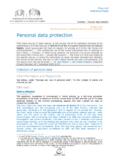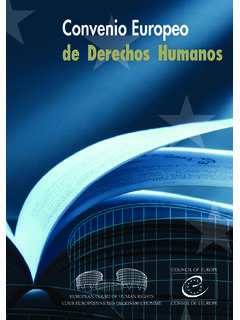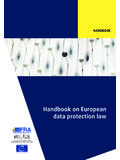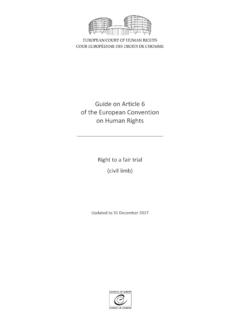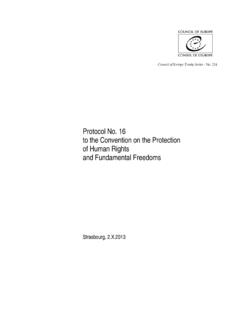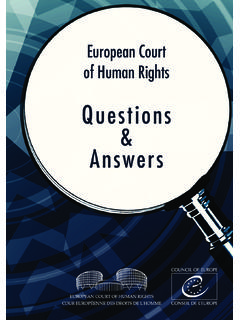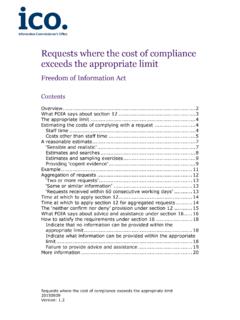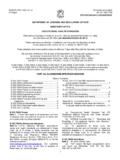Transcription of Guide on Article 6 of the European Convention on Human …
1 Guide on Article 6 of the European Convention on Human Rights Right to a fair trial (criminal limb) Updated on 31 December 2021 Prepared by the Registry. It does not bind the Court. Guide on Article 6 of the Convention Right to a fair trial (criminal limb) European Court of Human Rights 2/126 Last update: Publishers or organisations wishing to translate and/or reproduce all or part of this report in the form of a printed or electronic publication are invited to contact for information on the authorisation procedure. If you wish to know which translations of the Case-Law Guides are currently under way, please see Pending translations.
2 This Guide was originally drafted in English. It is updated regularly and, most recently, on 31 December 2021. It may be subject to editorial revision. The Case-Law Guides are available for downloading at (Case-law Case-law analysis Case-law guides). For publication updates, please follow the Court s Twitter account at Council of Europe/ European Court of Human Rights, 2022 Guide on Article 6 of the Convention Right to a fair trial (criminal limb) European Court of Human Rights 3/126 Last update: Contents Note to readers .. 5 I. General considerations of Article 6 in its criminal aspect .. 7 A. The fundamental principles .. 7 B.
3 Waiver .. 8 II. Scope: the notion of criminal charge .. 9 A. General principles .. 9 1. The existence of a charge .. 9 2. The criminal nature of a charge .. 10 B. Application of the general principles .. 11 1. Disciplinary 11 2. Administrative, tax, customs, financial and competition-law proceedings and other special proceedings .. 13 3. Political issues .. 14 4. Expulsion and extradition .. 14 5. Different stages of criminal proceedings, ancillary proceedings and subsequent remedies .. 15 III. Right of access to a court .. 16 Limitations .. 16 1. Parliamentary immunity .. 16 2. Procedural rules .. 17 3. Requirement of enforcement of a previous decision.
4 18 4. Other restrictions in breach of the right of access to a court .. 18 IV. General guarantees: institutional requirements .. 19 A. The notion of a tribunal .. 19 B. Tribunal established by law .. 20 1. The relevant principles .. 20 2. 22 C. Independence and impartiality .. 22 1. Independent tribunal .. 23 2. Impartial tribunal .. 25 V. General guarantees: procedural requirements .. 32 A. Fairness .. 32 1. Effective participation in the proceedings .. 32 2. Equality of arms and adversarial proceedings .. 33 3. Reasoning of judicial decisions .. 37 4. Right to remain silent and not to incriminate oneself .. 40 5. Administration of evidence.
5 42 6. Entrapment .. 45 7. The principle of immediacy .. 50 8. Legal certainty and divergent case-law .. 51 9. Prejudicial publicity .. 52 10. Plea bargaining .. 53 Guide on Article 6 of the Convention Right to a fair trial (criminal limb) European Court of Human Rights 4/126 Last update: B. Public hearing .. 54 1. The principle of publicity .. 54 2. The right to an oral hearing and presence at the 54 3. Exceptions to the rule of publicity .. 59 4. Public pronouncement of 60 C. Reasonable time .. 61 1. Determination of the length of proceedings .. 61 2. Assessment of a reasonable time .. 62 3. Several examples .. 64 VI. Specific guarantees.
6 65 A. The presumption of innocence ( Article 6 2) .. 65 1. Scope of Article 6 65 2. Prejudicial statements .. 68 3. Adverse press campaign .. 71 4. Sanctions for failure to provide information .. 71 5. Burden of proof .. 71 6. Presumptions of fact and of law .. 72 B. The rights of the defence ( Article 6 3).. 73 1. Information on the nature and cause of the accusation ( Article 6 3 (a)) .. 74 2. Preparation of the defence ( Article 6 3 (b)).. 77 3. Right to defend oneself in person or through legal assistance ( Article 6 3 (c)) .. 80 4. Examination of witnesses ( Article 6 3 (d)) .. 90 5. Interpretation ( Article 6 3 (e)).. 100 VII. Extra-territorial effect of Article 6.
7 103 A. Flagrant denial of justice .. 103 B. The real risk : standard and burden of proof .. 104 List of cited cases .. 106 Guide on Article 6 of the Convention Right to a fair trial (criminal limb) European Court of Human Rights 5/126 Last update: Note to readers This Guide is part of the series of Case-Law Guides published by the European Court of Human Rights (hereafter the Court , the European Court or the Strasbourg Court ) to inform legal practitioners about the fundamental judgments and decisions delivered by the Strasbourg Court. This particular Guide analyses and sums up the case-law on the criminal limb of Article 6 of the European Convention on Human Rights (hereafter the Convention or the European Convention ).
8 Readers will find herein the key principles in this area and the relevant precedents. The case-law cited has been selected among the leading, major, and/or recent judgments and decisions.* The Court s judgments and decisions serve not only to decide those cases brought before it but, more generally, to elucidate, safeguard and develop the rules instituted by the Convention , thereby contributing to the observance by the States of the engagements undertaken by them as Contracting Parties (Ireland v. the United Kingdom, 154, and, more recently, Jeronovi s v. Latvia [GC], 109). The mission of the system set up by the Convention is thus to determine, in the general interest, issues of public policy, thereby raising the standards of protection of Human rights and extending Human rights jurisprudence throughout the community of the Convention States (Konstantin Markin v.)
9 Russia [GC], 30078/06, 89, ECHR 2012). Indeed, the Court has emphasised the Convention s role as a constitutional instrument of European public order in the field of Human rights (Bosphorus Hava Yollar Turizm ve Ticaret Anonim irketi v. Ireland [GC], 156, and, more recently, and v. Spain [GC], 110). This Guide contains references to keywords for each cited Article of the Convention and its Additional Protocols. The legal issues dealt with in each case are summarised in a List of keywords, chosen from a thesaurus of terms taken (in most cases) directly from the text of the Convention and its Protocols. The HUDOC database of the Court s case-law enables searches to be made by keyword.
10 Searching with these keywords enables a group of documents with similar legal content to be found (the Court s reasoning and conclusions in each case are summarised through the keywords). Keywords for individual cases can be found by clicking on the Case Details tag in HUDOC. For further information about the HUDOC database and the keywords, please see the HUDOC user manual. * The case-law cited may be in either or both of the official languages (English and French) of the Court and the European Commission of Human Rights. Unless otherwise indicated, all references are to a judgment on the merits delivered by a Chamber of the Court.

